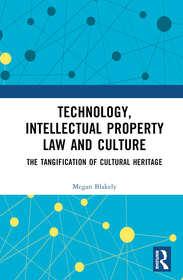
Technology, Intellectual Property Law and Culture
The Tangification of Intangible Cultural Heritage
- Publisher's listprice GBP 135.00
-
64 496 Ft (61 425 Ft + 5% VAT)
The price is estimated because at the time of ordering we do not know what conversion rates will apply to HUF / product currency when the book arrives. In case HUF is weaker, the price increases slightly, in case HUF is stronger, the price goes lower slightly.
- Discount 10% (cc. 6 450 Ft off)
- Discounted price 58 047 Ft (55 283 Ft + 5% VAT)
Subcribe now and take benefit of a favourable price.
Subscribe
64 496 Ft

Availability
Estimated delivery time: In stock at the publisher, but not at Prospero's office. Delivery time approx. 3-5 weeks.
Not in stock at Prospero.
Why don't you give exact delivery time?
Delivery time is estimated on our previous experiences. We give estimations only, because we order from outside Hungary, and the delivery time mainly depends on how quickly the publisher supplies the book. Faster or slower deliveries both happen, but we do our best to supply as quickly as possible.
Product details:
- Edition number 1
- Publisher Routledge
- Date of Publication 18 June 2024
- ISBN 9780367439750
- Binding Hardback
- No. of pages176 pages
- Size 234x156 mm
- Weight 490 g
- Language English
- Illustrations 3 Illustrations, black & white; 3 Line drawings, black & white; 5 Tables, black & white 671
Categories
Short description:
Focusing on cultural expressions that are most likely to intermingle with copyright law, trademark and IP-adjacent regulations, this book examines contemporary issues in technology, intellectual property law, and culture.
More
Long description:
Focusing on cultural expressions that are most likely to intermingle with copyright law, trademark and IP-adjacent regulations, this book examines contemporary issues in technology, intellectual property law, and culture.
Intangible Cultural Heritage can consist of traditional knowledge, songs, craftsmanship, dance, and other practices, as well as the associated cultural artefacts and spaces; a widely varied global living heritage, transmitted generationally, must be allowed to organically evolve, often defying the process of identification so desirable in the realm of legal protections. This nebulous essence is particularly ill-suited to modern legal frameworks that can conflate the creative outputs that copyright is meant to protect with shared cultural practices. Combining a legal perspective with historical tact, the book develops a theoretical model to track the interaction amongst these issues as well as to make policy recommendations based on the existing and projected possible future outcomes. Several chapters of the book will be dedicated to contemporary issues where this framework and interaction are currently developing, focussing on law and technology issues with archiving and museums, online platforms and copyright infringement, and communities and creative production in virtual worlds.
The book will be of interest to students and scholars in the field of copyright law and intellectual property law.
‘The book constitutes an insightful examination of the divide between “knowledge producing” countries with a more IP law focus belonging to the developed side of the world and “culture producing” developing countries rich in ICH, which in the end can be bridged through better international cooperation and inclusion of both ICH and IP law issues into legislation and policy discussions.'
Victoria Dipla (Greek Lawyer, IGNITE Trainee Solicitor Clifford and Chance LLP London), IPKat Blog
‘Rich in detail, but accessible for a those who are not specialists in law, technology, or heritage, the book is essential reading across the humanities and social sciences, as well as for anyone interested in how best to support and preserve the past.'
New Books Network Critical Theory
MoreTable of Contents:
1. Introduction
2. The Law
3. Theoretical Framework (Tangification)
4. Cultural Adoption and Tangification: The Process of Intangible Cultural Heritage Becoming Intellectual Property
5. Historical Cultural Expressions: Tangification and Legal Development
6. Contemporary Cultural Guardians: Archives, Museums, and Digitisation
7. Future Evolution: Virtual Worlds, User Communities, and Creative Contributions
8. Conclusion and Recommendations
More




